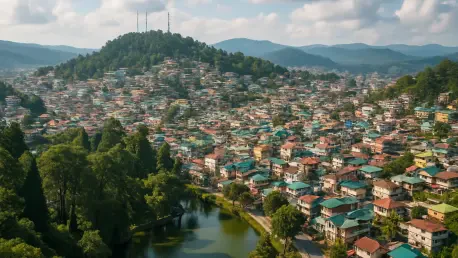Imagine stepping into a land where misty hills roll endlessly, vibrant markets buzz with life, and ancient traditions blend seamlessly with modern charm, making Shillong, the capital of Meghalaya, a captivating destination. Often dubbed the “Scotland of the East,” this city has captured the hearts of travelers across India and beyond. Nestled in the lush landscapes of the Northeast, this city stands as a beacon of natural beauty, cultural richness, and adventure. This roundup gathers insights, tips, and reviews from various travel experts, bloggers, and local guides to uncover why Shillong has become a must-visit destination. The purpose is to provide a comprehensive look at what makes this city so special, comparing diverse perspectives to help travelers plan an unforgettable journey.
Diverse Perspectives on Shillong’s Natural Beauty
Shillong’s landscapes are often described as a painter’s dream, with cascading waterfalls and serene lakes dotting the region. Travel bloggers frequently highlight Elephant Falls as a standout attraction, praising its three-tiered structure surrounded by emerald greenery. Many note that the site offers not just scenic views but also a calming escape, ideal for photography enthusiasts and nature lovers seeking tranquility. Local tourism boards report a significant increase in footfall at such spots, emphasizing their role in drawing global attention to the city’s pristine environment.
On the other hand, some environmental advocates express concern over the growing number of visitors. They argue that while places like Umiam Lake, a sprawling waterbody perfect for boating, are breathtaking, the influx of tourists poses risks to fragile ecosystems. Suggestions for sustainable practices, such as limiting plastic use and adhering to designated trails, often surface in their reviews. This balance between appreciation and preservation remains a key point of discussion among those who have explored these natural wonders.
A contrasting view comes from adventure-focused travel groups who see Shillong’s landscapes as more than just picturesque. They point out that the rugged terrain around Laitlum Canyons provides dramatic vistas that rival any postcard image. Their accounts often focus on the thrill of discovery, urging visitors to look beyond passive sightseeing and engage with the land through exploration, while still respecting conservation guidelines shared by local authorities.
Cultural Vibrancy: A Melting Pot of Opinions
Shillong’s cultural scene garners widespread acclaim for its authenticity and energy. Travel writers often rave about Police Bazaar, describing it as a chaotic yet charming hub where one can find everything from handmade crafts to local delicacies. Their tips usually include spending a full day wandering through stalls, interacting with vendors, and soaking in the daily life of the Khasi community. Festivals like the Cherry Blossom Festival in November also receive high praise for transforming the city into a floral spectacle paired with music and art.
Local guides, however, offer a deeper perspective on cultural immersion. They emphasize events like the Nongkrem Dance Festival as a window into indigenous traditions, where visitors can witness sacred rituals and vibrant performances. Their advice often centers on respecting local customs, such as dressing modestly during such events and seeking permission before photographing ceremonies. This insight helps travelers connect meaningfully with the heritage rather than merely observing it as a spectacle.
A differing opinion emerges from some cultural critics who caution against the commercialization of these traditions. They note that while tourism boosts the economy, there’s a risk of diluting sacred practices for entertainment. Their reviews suggest seeking out lesser-known community events or homestays to experience Shillong’s culture in a more authentic, unfiltered way. This debate highlights the need for mindful engagement as the city’s popularity grows.
Historical Insights and Modern Innovations
Shillong’s historical landmarks offer a fascinating glimpse into its past, and opinions on their significance vary widely. Travel historians often point to the Cathedral of Mary Help of Christians as a striking example of colonial architecture, blending spiritual resonance with aesthetic appeal. They recommend guided tours to understand the city’s layered history, including its role as a British administrative center in the Northeast. Such narratives add depth to a visitor’s experience beyond scenic attractions.
Digital travel platforms, meanwhile, focus on how technology enhances historical exploration. They highlight virtual tours and interactive exhibits at places like the Don Bosco Centre for Indigenous Cultures, which showcases tribal heritage through multimedia displays. Reviews suggest that these modern tools make history accessible to younger audiences and those unable to visit in person. Looking ahead, some predict that such innovations will expand further by 2027, potentially setting a benchmark for tourism in the region.
A contrasting viewpoint comes from local educators who argue that Shillong’s historical value is often overshadowed by its natural allure. They advocate for more emphasis on educational tourism, encouraging schools and universities to organize trips to these sites. Their tips include pairing visits with workshops on indigenous history to foster a deeper appreciation among travelers, positioning the city as a learning hub as much as a leisure destination.
Adventure Offerings: Thrills in the Hills
For adventure seekers, Shillong is a playground of rugged trails and panoramic views, and reviews from this community are overwhelmingly enthusiastic. Outdoor bloggers frequently cite Shillong Peak as a top spot, offering challenging treks with rewarding 360-degree vistas of the surrounding hills. Their advice often includes starting early in the morning to avoid crowds and capture the best light for photography, along with packing adequate gear for unpredictable weather.
Local adventure guides provide a more practical take, stressing safety and preparation. They note that while the thrill of scaling heights at Laitlum Canyons is unmatched, the terrain can be demanding for novices. Their recommendations include hiring experienced guides and following marked paths to prevent accidents. Many also share stories of how these treks foster a sense of camaraderie among participants, adding a social dimension to the physical challenge.
Some travel analysts, however, raise concerns about the infrastructure supporting adventure tourism. They point out that while the potential for economic growth through such activities is immense, the lack of robust safety regulations and facilities could hinder long-term success. Their insights suggest that investment in training programs for guides and better trail maintenance could elevate Shillong’s standing among India’s premier adventure destinations, a topic likely to gain traction in coming years.
Practical Tips from the Travel Community
Compiling tips from various sources, planning a trip to Shillong requires attention to timing and approach. Many seasoned travelers recommend visiting during November to catch the Cherry Blossom Festival, when the city blooms with pink flowers and cultural events. They suggest a 4-5 day itinerary covering natural sites like Umiam Lake, cultural hubs like Police Bazaar, and a trek to Shillong Peak for a well-rounded experience. Booking accommodations in advance during peak seasons is also a common piece of advice.
Sustainability emerges as a recurring theme in travel forums. Contributors often urge visitors to support local artisans by purchasing directly from markets rather than chain stores, ensuring economic benefits reach the community. Additionally, sticking to eco-friendly practices, such as carrying reusable water bottles and avoiding single-use plastics, is frequently mentioned as a way to minimize environmental impact while exploring the hills and waterfalls.
A final tip from multiple reviewers focuses on engagement with local guides for treks and cultural tours. They argue that such interactions not only enhance safety but also provide insider knowledge about hidden spots and untold stories. This collective wisdom underscores the importance of traveling with intention, ensuring that a visit to Shillong leaves a positive footprint on both the land and its people.
Reflecting on Shillong’s Multifaceted Charm
Looking back, this roundup captures a spectrum of voices that paint Shillong as a destination of unparalleled diversity, blending serene landscapes, vibrant traditions, historical depth, and thrilling adventures. The insights from travel bloggers, local guides, and cultural critics reveal a city that captivates with its beauty while grappling with the challenges of preservation and growth. For those inspired to explore, the next step could involve delving deeper into sustainable travel resources or connecting with local communities online to plan a trip that respects Shillong’s essence. Considering curated itineraries that balance popular attractions with offbeat experiences might offer a fresh perspective on this Northeast gem. Ultimately, the journey to Shillong promises to be as enriching as the destination itself, inviting travelers to contribute to its enduring legacy.









